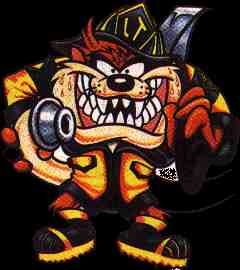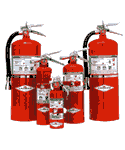
Fire Prevention Information
Fire Prevention is everyone's business, and is not just for
Fire Prevention Week. Please look the following information over
carefully, and share it with your loved ones.
Teaching firesafety to children is one important thing we do. Please look over our Fire Prevention Program
as presented at Guardino Elementary School
Stop, Drop, & RollX
Get Ready for a FireX
Smoke DetectorsX
Stay Low & Go
Get Out & Stay OutX
EDITHX
Dialing 9-1-1
CPR X
Fire Extinguishers X
Blue Lights
.gif)
Stop, Drop & Roll
This basic skill can be taught to very young children, and is taught at Guardino Elementary. The important thing is to cover the face with the hands and roll around until
the fire is out. One method that can be used to emphasize this is to tape small balloons to a child and have them roll around until
all the balloons have popped.
Remember that adults need to know how to Stop Drop and Roll as well.
Return to Top of Page
GET READY FOR A FIRE
No one expects a fire in their home, but they do happen. You help minimize the damage to your home and the danger
to you and your family by paying attention to the items that follow:
Return to Top of Page
Smoke Detectors
 Smoke detectors save lives. It's that simple. Have a smoke detector on each living level of your home, and change the
batteries once a year (when you change your clock in the fall is a good time). Most detectors recommend a monthly test.
Read the instructions that came with your smoke detector. Mark your calendar so you don't forget.
Smoke detectors save lives. It's that simple. Have a smoke detector on each living level of your home, and change the
batteries once a year (when you change your clock in the fall is a good time). Most detectors recommend a monthly test.
Read the instructions that came with your smoke detector. Mark your calendar so you don't forget.


Return to Top of Page
.gif)
Stay Low and Go
Smoke and heat rise. That's the main reason for staying low. But some toxic gasses from a fire can actually settle to the floor.
For that reason, we teach that it's best to say on your hands and knees - with your face at about the same level as most electrical
outlets. But the most important thing is to GO! You may have only seconds to escape from fire.
Return to Top of Page
.gif)
Get Out and Stay Out
Once you've gotten out of the fire building, STAY OUT! Many people have been killed or seriously injured while returning to
a burning building from which they just successfully escaped . No possesion, no matter how dear, is worth losing your life over.
And don't forget to establish a meeting place, and to go there.
Return to Top of Page
.gif)
EDITH
Exit
Drills
In
The
Home. We all think we know how to get out of our houses, but that's usually
during the day, or with the lights on.
During a fire, familiar landmarks will disappear. Conduct fire drills in your home. One tactic used at our elementary
school is to declare an exit blocked, forcing the students and teachers to use an alternate exit.
You can also use a technique firefighters sometimes use to drill for rescues - blindfold family members
(or at least have them close their eyes) and have them find their way out of the house. Be sure to monitor
them so they don't take a tumble down stairs, etc, or somehow tip over the china cabinet.
Don't forget about that meeting place!
Return to Top of Page
.gif)
Dialing 9-1-1
Dialing 9-1-1 can be a lifesaver. In Jefferson County we are fortunate to have the Enhanced version - the address of the
caller is displayed for the emergency operator. Not all areas have this feature, nor do cell phones at this time.
In any case, the following guidelines apply:
If your house is on fire, get out and call from a neighbor's house;
Tell the operator who you are;
Tell the operator why you are calling;
Tell or confirm with the operator you address;
Stay on the line until the emergency operator hangs up.
Remember (and teach your children) that 9-1-1 is not a plaything. If you want to have your children practice dialing 9-1-1,
be sure to stay on the line and explain to the operator why you called.
Return to Top of Page
.gif)
Cardiopulmonary Resuscitation (CPR)
CPR saves lives. IF it is started in a timely manner, and is done properly. You can learn all you need to know
about CPR in a day, or a couple of evenings. Just think - you give up a day out of your busy schedule so someone,
perhaps a loved one, can have many more days. Contact your local American Red Cross or American Heart Association
chapter for information on courses near you. If there aren't any, see what you can do to organize them.
Return to Top of Page
.gif)
How to use Fire Extinguishers

Be familiar with your fire extinguishers (you do have fire extinguishers, don't you?), and what they can do.
Read the instructions that came with the extinguisher, as well as the directions on the extinguisher itself.
Most fire extinguishers operate in a similar manner:
1. If it's bad enough to use a fire extinguisher, call the fire department, too.
2. Make sure you can get out;
2. Pull the pin;
3. Aim at the BASE of the flames;
4. Squeeze the handle, sweep from side to side at the base of the flames.
5. If the extinguisher won't put the fire out, GET OUT!
CLASSES OF FIRE EXTINGUISHERS
A - Combustible solids - wood, paper, etc
B - Combustible liquids - oil, gas
C - Electrical
D - Combustible metals - magnesium, etc. This requires special extinguishing agents.
Most home fire extinguishers will handle A, B, and C fires, and are labelled ABC.
Return to Top of Page
.gif)
Blue Lights
The blue light is the one thing the New York state volunteer firefighter has to let other motorists know who he (or she) is and that he is responding
to an emergency. While the blue light is strictly a courtesy light - that is, it gives the driver no special priviledges - it is important
for other motorists to extend as much courtesy as possible to those displaying flashing blue lights. The same is true for green
lights, which are assigned to volunteer ambulance corps. Remember - someone, somewhere, has an emergency. Someday
that person could be you!
Last Update March 22, 2000

